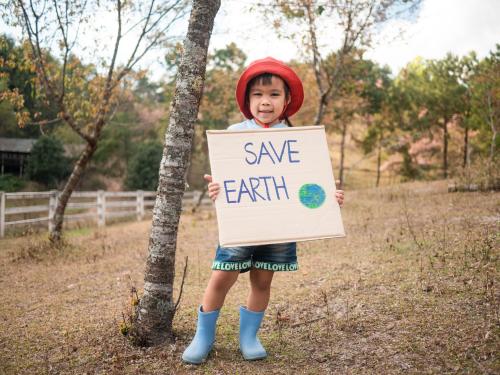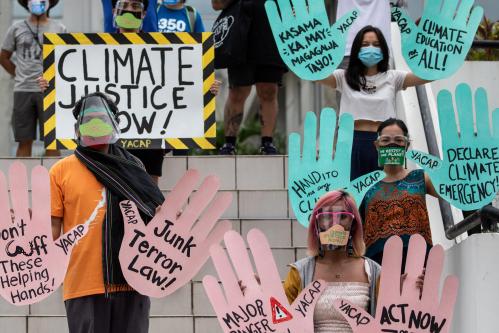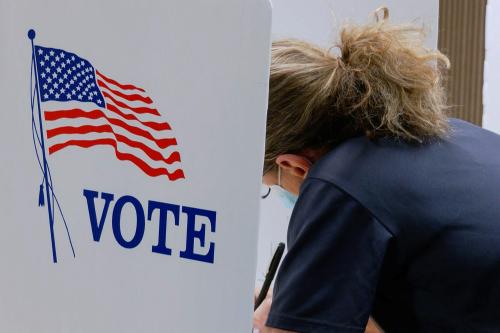Contents
- Summary
- Challenge
- Limits of historic and existing policies
- Policy recommendations
- Conclusion
- Appendices
Summary
As the United States looks to more proactively mitigate and adapt to climate change during the Biden administration, federal leaders should center the people vital to managing these responses—from students to workers to business owners—around these efforts. The country’s ability to reduce climate risks and costs, especially around greenhouse gas emissions, depends on its ability to transform the underlying behaviors, mindsets, and social and economic structures of inequality driving these climate challenges in the first place. And to achieve such transformation, the federal government must better coordinate a national strategy around climate education and workforce development that advances both climate action and climate justice.
Research shows that climate education can help reduce emissions as much as our best technological innovations, while also reducing people’s vulnerabilities to acute and chronic environmental hazards. This is especially important for low-income communities and communities of color where structural inequities have magnified the social, health, and economic risks and effects of climate change. Many of these same communities have also been historically excluded from the education and training opportunities that could increase their resilience and adaptability.
However, as the Biden administration looks to embrace more equitable, forward-looking climate solutions over the next four years, prioritizing climate education and training can build climate literacy, foster “green” skills, and achieve greater climate justice in the transition to a cleaner, more resilient economy. This Blueprint examines how federal leaders can advance a new green learning agenda—a new framework to unlock the transformative potential of climate education and training—by empowering the U.S. Global Change Research Program (USGCRP). It recommends two key improvements: (1) creating a new mandate and budget for the USGCRP to coordinate federal action around climate education and training, and (2) establishing an interagency Action for Climate Empowerment (ACE) Working Group to chart future planning and engagement with the Education Department (ED) and Department of Labor (DOL).
Challenge
While there is increasingly broader acceptance of the importance of building learners’ climate literacy and green skills across their lifetime, the U.S. (and the majority of countries in the world) lacks a climate-focused educational framework and workforce development system that prepares Americans to adapt and respond to climate change. The decentralized nature of the U.S. education system and the politicization of climate change further limits policy coherence and coordination across the 50 states and their K-12, higher education, and career and technical education systems.
The absence of a “green” learning agenda—or a way of educating and engaging Americans to address climate change while enhancing social equity—and federal mechanisms to coordinate its implementation come at a high price. Chronic climate challenges such as flooding and extreme heat, alongside acute shocks including major storms, are devastating low-income communities the hardest, leading to their further marginalization and threatening to widen inequality in the U.S. Without everyone on board equally equipped with the knowledge, skills, and mindsets to tackle climate change, U.S. climate ambition will remain a pie in the sky.
Key to understanding this present landscape are four gaps—one of which currently preoccupies the bandwidth of many policymakers, and the remaining three to which federal leadership must turn its attention.
- Climate change is a technical challenge demanding technical innovations to close the emissions gap—or the difference between the projected level of greenhouse gas emissions and the level of emissions needed to achieve the 1.5 degrees Celsius target of the Paris Agreement. Policy discussions in the media and academic literature are dominated by evaluations and explanations of carbon taxation models, renewable energy innovations, green infrastructure development, and other financial and material projects.
- Climate change is also an adaptive challenge that requires attention to an education gap. This gap describes the lack of knowledge and awareness among students, workers, and the general public about climate change, including its anthropogenic causes, social and political drivers, unequal impacts, and various solutions. This gap is fueled in large part by the fact that basic climate science is not being taught in schools or communicated to the public. For instance, currently only 29 states and the District of Columbia have science standards that require the teaching of climate change, and only five states have social science standards that do the same. Meanwhile, at least 12 states have proposed legislation that actually interferes with the teaching of climate change in schools. And when it comes to classrooms, an NPR/IPSOS study found that while nearly 90 percent of teachers believe climate change should be taught in schools, only about 45 percent of teachers actually do. Another study found that half of science teachers teach climate change for less than two hours a year, with at least a quarter giving equal time to perspectives that raise doubt about climate change. It comes as no surprise that, for example, only 24 percent of adults in America understand that consuming less meat can have a large environmental impact.
- The green (or clean) economy—the sector of the economy that produces goods or services with an environmental benefit—offers a path to lower emissions, greater resilience, and millions of jobs. However, its realization is heavily constrained by a training gap—a lack of sustained educational and workforce development programming that can support a consistent pipeline of talent for green careers. Confusion over what types of occupations and industries are even in the green economy limits targeted investments and hampers our ability to move beyond ad hoc, short-term funding. In turn, current and prospective workers may lack access to the type of training needed—the apprenticeships and internships, for instance, that are vital in many related skilled trades careers. And these workers may fail to develop the wide range of specific, generic, and transformative capacities, or green skills, that are necessary for an unencumbered transition to a more equitable and inclusive economic system (see Appendix 1). For example, nearly half of career and technical education programs in the U.S. do not offer training and certification in related industries. The challenge is even more severe when considering all the workers retiring or leaving skilled trades careers; in several infrastructure-related occupations, up to a quarter of workers leave their positions on average each year, compared to about 10 percent for all workers nationally.
- Closing the education, training, and emissions gaps will require closing a fourth gap—one of uneven access to quality and empowering learning opportunities. This inequality gap impacts underrepresented and underserved groups—especially girls and women, indigenous populations, and people of color—who, due to long-standing structures of discrimination and historic trends of disinvestment, have fewer opportunities to gain the skills, experiences, and networks to participate and lead in economic and political life and decisionmaking. These inequalities—which some would also argue are civil rights issues—should not be overlooked in future federal climate strategies. The Intergovernmental Panel on Climate Change (IPCC) has suggested that social justice and equity are core aspects of any strategy to limit warming to 1.5 degrees Celsius. Without simultaneously reducing racial and gender inequality, eradicating poverty, and multisolving other development challenges—challenges from which the U.S. is not removed—the country’s best laid climate plans will go unrealized because those people crucial to the innovation, design, and implementation of climate-friendly policies and programs were left behind.
Limits of historic and existing policies
A principal challenge to close the emissions, education, training, and inequality gaps is coordinating and scaling the adoption of a new green learning agenda in the U.S. (see Appendix 2 for more details on what this agenda exactly entails). Federal leaders must overcome several policy and institutional hurdles to organize programs and launch investments around more consistent, widespread climate education and workforce development.
The US Global Change Research Program (USGCRP)
Article 6 of the United Nations Framework Convention on Climate Change (UNFCCC) and Article 12 of the Paris Agreement both acknowledge the important role for education, training, and public awareness (dimensions which together are also known as Action for Climate Empowerment or ACE) to empower all members of society to engage in climate action. Indeed, the 2012 Doha Work Programme on ACE encourages all countries to develop a national ACE strategy and to designate a national ACE focal point who will coordinate and strengthen such educational opportunities. To date, over half of country signatories to the Paris Agreement have appointed a national ACE focal point.
In contrast, the U.S. has never designated an ACE focal point or a national coordinator for climate change education and training, nor has it developed an ACE strategy or equivalent green learning agenda. The U.S. Global Change Research Program (USGCRP, see Box 1) was mandated by Congress to serve as an interagency coordinating body for climate science across the federal government. This mandate puts the USGCRP in a central position to serve as a coordinating entity for a new green learning agenda. But doing so will require a clearer and stronger mandate on climate education in its next strategic plan and go beyond building a federal climate science workforce.
|
Box 1. Background on the US Global Change Research Program
The USGCRP is steered by the Subcommittee on Global Change Research under the National Science and Technology Council’s Committee on Environment and overseen by the White House Office of Science and Technology Policy. It was established in 1989 by presidential initiative during the Reagan administration, and later mandated by Congress in 1990 with the passing of the Global Change Research Act. The USGCRP, through its National Coordination Office and interagency working groups, provides interagency collaboration and coordination of needs and investments by federal agencies in climate change research.
The 13 federal member agencies that make up USGCRP include: Department of Agriculture, Department of Commerce, Department of Defense, Department of Energy, Department of Health and Human Services, Department of the Interior, Department of State, Department of Transportation, Environmental Protection Agency, National Aeronautics and Space Administration, National Science Foundation, Smithsonian Institution, and U.S. Agency for International Development. |
At present, the USGCRP’s 2012-2021 Strategic Plan recognizes the need to build a climate literate workforce before students hit college-age and especially among underrepresented groups. Yet its strategy largely overlooks K-12 education, and its approach to workforce development is reactive rather than proactive, responding to specific requests for training resources on climate change from federal agencies like Resilience AmeriCorps. One of the USGCRP’s stated objectives is to prepare the nation for change, including increasing “understanding [of] the forces shaping the global environment, both human and natural, and their impacts on society.” However, the USGCRP’s education activities remain low on its priorities compared to investments in scientific research due to a corresponding prioritization by the offices that are represented in USGCRP.1
While the USGCRP does provide limited resources for educators, including lesson plans and a climate literacy framework, much of the federal government’s climate change education and training efforts are agency-specific activities that appear to have little connection to the USGCRP. For instance, our analysis of the 13 USGCRP member agencies’ climate change education activities suggest that nearly 90 percent of programs, initiatives, and materials come from four agencies (the Environmental Protection Agency, NASA, the National Oceanic and Atmospheric Administration, and the Smithsonian Institution)—efforts stemming from parts of these agencies with few ties to the USGCRP. Of these resources, only 16 active initiatives and/or materials explicitly focus on supporting teacher training in climate change. Such limited, inconsistent, and uncoordinated attention to education for climate action within the USGCRP and across its member agencies undercuts the USGCRP’s leadership potential, as well as its ability to effectively prepare the nation to respond to and mitigate climate change.
However, notably absent from the USGCRP are the Department of Education (ED) and the Department of Labor (DOL), two agencies whose missions to ensure quality education and workforce development opportunities would make them natural co-coordinators of a new green learning agenda. Their engagement could also provide the USGCRP with important policy and financing mechanisms to compel state and local education and training systems to adapt a new green learning agenda in ways that make sense locally. Not only are ED’s and DOL’s absences alarming, but the lack of coordination within these two agencies also undermines the country’s ability to deliver a cohesive, holistic, and lifelong green learning agenda that covers K-12 education to career and technical education to adult learning programs.
The Education Department (ED)
The ED’s federal role in a state-driven education system is to fill important gaps that states and other local education authorities cannot, especially in times of national crisis like our present climate crisis. As mentioned earlier, 29 states and the District of Columbia have science standards—including the Next Generation Science Standards—that require the teaching of climate change, while at least 12 states have proposed legislation that would require teachers to “teach the controversy” or to remove material about climate change. The politicization of teaching climate change has made it a nearly impossible task for states to integrate climate change into the curriculum—and perhaps explains why the ED’s approach to “green education” has thus far been largely focused on the relatively less political issue of awarding green ribbon schools.
Yet, even though the majority of teachers report that they think climate change should be taught in school, they do not teach it themselves because they lack expertise or do not understand how it relates to their subject area. This challenge is not about politics but about capacity building. Research suggests that increasing teachers’ content knowledge about climate change (including its connections to different subject areas) and increasing their access to quality teaching and learning materials is an important step to empower them to be agents of change for climate. But the ED has yet to fill this void by taking actions to curate resources, create training opportunities, or to direct federal funding that could help to incentivize teacher professional development programs. Rather, it has been agencies like the Environmental Protection Agency (EPA) and NASA that have been stepping into the role of supporting teachers.
The Department of Labor (DOL)
Preparing workers for green careers is a challenge when career and technical education remains stigmatized, siloed, and underfunded, despite efforts to showcase the importance of infrastructure and skilled trades in supporting a just, green transition. While there was an Obama-era executive order that led DOL to develop an environmental justice strategy, DOL has not advanced much action on this front and is preoccupied with managing many already stretched workforce development systems. Instead, infrastructure-focused agencies such as the EPA, Department of Transportation, and Department of Energy have elevated the importance of workforce issues in recent years—including a Water Workforce Initiative, Ladders of Opportunity Initiative, and a STEM Rising Initiative—but there is still a lack of coordination and sustained funding across the federal bureaucracy.
One of the biggest ongoing challenges is even defining the types of positions—and careers—in a green economy. Skilled trade careers are vital in this respect, as are a broader range of administrative, management, and financial positions that support utilities and environmental management and conservation. And, more often overlooked in green job taxonomies are care jobs (e.g., in education and health care), which fulfill the critical function of strengthening society’s climate resilience and adaptive capacity, especially for low-income communities and communities of color. While DOL (and many other national organizations) have tried to better define and quantify the extent of our green workforce, there is still a lack of emphasis on the processes by which certain groups of people are disproportionately entering these career pathways. For example, since many positions are in the skilled trades, additional work-based learning is crucial; internships, apprenticeships, pre-apprenticeships, and other earn-and-learn models can expose prospective workers to the types of careers in this space and provide needed on-the-job training. Federal leaders need to better address the barriers that current and prospective workers face to gain needed competencies and grow their careers, while also connecting more and different types of individuals to green careers, including women and people of color, by building off the momentum of new sector partnerships and collaborations at a regional level.
Policy recommendations
To accelerate a green, just economic transition, a blueprint for action must start with people. To empower people, especially those who have been historically marginalized and harmed by climate change, the U.S. must adopt and deliver a national strategy around a human-centered green learning agenda (see Appendix 2). With a focus on climate education and workforce development, this national strategy can help feed into longer-term plans and programs throughout the country, and enable the U.S. to fulfill Article 12 under the Paris Agreement. This strategy would recognize state and local control over educational and training programs specific to individual regions, while giving the federal government a critical coordinating role in scaling action across multiple tiers of the U.S. education system, including formal education systems, higher education, career and technical education systems, teacher training institutions, and continuing education programs.2
To jumpstart action and set the country on this course, the Biden administration should focus on two key efforts. First, on the heels of rejoining the Paris Agreement, it should empower the USGCRP with a mandate and budget to serve the critical federal leadership role and interagency coordinating function of a nationwide new green learning agenda. Second, over the next year, the administration should create a USGCRP ACE Working Group that engages the ED and DOL to advance a 50-state strategy on the education and training of all learners—from school children to adults—for climate action. These two efforts together can lead to additional conversations and actions among federal agencies over the next four years and beyond, paving the way for state and local adoption.
1. Empower the USGCRP with a mandate and budget to serve the critical federal leadership role and interagency coordinating function of a nationwide green learning agenda.
The urgency and scale of the climate crisis demand a coordinated, whole of government approach. The USGCRP already exists as an interagency coordinating body focused on preparing the nation for climate change. It now needs to be empowered with a clearer and stronger mandate—backed with an appropriate budget—to coordinate a nationwide new green learning agenda that makes closing the nation’s education gap through education and training a priority equal to closing the nation’s emissions gap through scientific research and innovations.
To do this, the Biden administration should, through executive action, expand the USGCRP’s mission and membership to prepare the nation for climate change by building American climate resilience and adaptive capacity through the coordination and implementation of quality education and training for climate action. To do this, the USGCRP—with ED and DOL as new member agencies—and the Office of Management and Budget (OMB) should adopt a new green learning agenda as an interagency priority, of which activities, progress, and outcomes should be monitored and included in the USGCRP’s annual reporting to Congress.
Within the USGCRP, education and training priorities should be coordinated through the creation of a new Subcommittee on Global Change Education (SGCE), parallel to the Subcommittee on Global Change Research (SGCR) that includes representation by the ED and DOL. A first task that the SGCE, together with the OMB, should take is to ensure the next USGCRP Strategic Plan prioritizes a new green learning agenda through the coordination of federal funding for climate education and training activities, including research on best practices that support this agenda.
An expanded mission and membership would also help increase the USGCRP’s budget crosscut and the corresponding budget for the National Coordination Office, whose staff and programmatic capacity must be boosted in order to successfully coordinate a nationwide green learning agenda. At its peak, the climate change research budget of USGCRP’s 13 agencies was approximately $2.6 billion. We anticipate the need for an increase of roughly $2 billion in agency funding dedicated to activities and research that promote the education and training of children, youth, and adults for climate action, with a particular emphasis on low-income communities and communities of color. To facilitate this, Congress would need to allocate a portion of member agency budgets toward education and training for climate action, resulting activities of which would be coordinated by the USGCRP. For example, pivoting the Perkins Bill toward supporting a new green learning agenda in career and technical education could on its own provide half of the needed expansion of the USGCRP’s budget crosscut. Such investments in education and training could lead to a much higher return when preparing the nation for climate change, compared to physical infrastructure upgrades alone.
2. Create an interagency ACE Working Group within the USGCRP that engages ED and DOL to advance a 50-state strategy for the education and training of all learners for climate action.
The newly created SGCE should create an interagency ACE Working Group that includes senior career officials from the ED and DOL, with representation across genders and race and with programmatic and budgetary responsibility in this area. This working group should:
- Name a U.S. ACE focal point in the next few months, who will also chair the ACE Working Group in the USGCRP.
- Develop a USGCRP budget for education and training activities (including identifying which existing and new member agencies will contribute to this budget).
- Identify existing legislative mechanisms to unlock federal financing mechanisms (from the Perkins Bill to Pell Grants to federal National Science Foundation grants) to empower state-level development, dissemination, and implementation of a new green learning agenda.
Over the next year, the interagency ACE Working Group should regularly engage ED and DOL through seconded civil servants or deputy administrators to help support the work of the USGCRP. This work should include convening the ACE community of stakeholders across the country to build off of the ACE National Strategic Planning Framework for the United States to develop a U.S. ACE Strategy, ideally around the 26th U.N. Climate Change Conference (COP26) in November 2021. This work would also involve coordinating the development of a 50-state strategy on education for climate action that aligns with the U.S. ACE Strategy and contextualizes a green learning agenda to the diverse educational, workforce, and green transition needs of communities across the U.S.
The interagency ACE Working Group should also work closely with ED and DOL leadership to set the education and communications goals of the USGCRP’s next strategic plan (set to be renewed in 2022). This strategy should not only include identifying pathways to translate and disseminate USGCRP research and information into appropriate, relevant, and effective curricula, training resources, and public awareness campaigns, but should also expand USGCRP research to include research collaborations with ED and DOL on climate change education, training, and communications. This would help to develop feedback loops (e.g., monitoring and evaluation, longitudinal tracking, etc.) within the USGCRP’s work coordinating a new green learning agenda, developing a green workforce, and empowering bolder, more equitable U.S. climate action.
Finally, the interagency ACE Working Group should also coordinate the monitoring of and reporting on U.S. commitments to Article 12 (ACE) of the Paris Agreement through its national communications to the UNFCCC. Such monitoring and reporting would be akin to what the USGCRP presently does with its National Climate Assessment reporting to Congress.
Appendix 3 outlines additional actions to follow these efforts, including: expanding the scope of ED’s Green Strides initiative to include green learning and climate justice; reviewing the National Career Clusters Framework to consider how each cluster and career pathway can contribute to climate action; and following the principle of incremental fusion to help school districts increase the capacity of teachers to incorporate a new green learning agenda into their existing subject areas, lessons, and objectives.
Conclusion
Globally and in the U.S., there are urgent calls by climate activists and educators to prepare present and future generations to face the challenges of climate change, to support communities impacted by a green energy transition, and to right the wrongs in marginalized and underserved communities that have experienced environmental injustices. Among these calls for climate justice is increased attention to education and training as one of our greatest strategies to ensure learners of all ages have the knowledge and tools to respond to climate change and to support actions toward a just transition to a greener, cleaner economy.
A more empowered USGCRP, together with ED and DOL, can play a critical federal leadership role in ensuring U.S. action on climate change is at once focused on addressing the U.S. emissions challenge and its education challenge. Indeed, our nation’s ability to achieve net-zero emissions in 30 years is dependent on our ability to transform the underlying behaviors, mindsets, and social and economic structures of inequality driving our emissions in the first place. And to do this, the country needs a holistic approach to quality education for climate action—a new green learning agenda. A national focal point like the USGCRP is an essential ingredient to coordinating a bolder U.S. educational response to climate change.
Appendices
Appendix 1. Redefining green skills through a climate justice lens
Green skills have been traditionally defined as “skills for sustainability” or “the professional knowledge, abilities, values, and attitudes needed in the transition to the green economy.” However, such framing reflects a narrow breadth of skills focused on the technical skills required by a subset of green jobs associated with the fields of science, technology, engineering, and mathematics (STEM), leading to the conflation of green skills as STEM skills.
A Brookings report—using a climate justice lens to analyze a diverse body of literature from the fields of climate change education, green economics, environmental psychology, organizational development, and transformative learning—attempts to redefine green skills based on the dominant environmental and social outcomes to which individual and clusters of skills were discursively associated.
- Specific capacities include technical skills needed to thrive in green jobs supporting a low-carbon green economy, including care jobs like teaching, child care, and nursing (e.g., industry-specific skills like elder care, construction, programming, mechanical maintenance and repair, early childhood development, and coding).
- Generic capacities include cross-cutting “life skills” or “21st century skills” that contribute to greener ways of thinking, being, and doing (e.g., problem-solving, critical thinking, active listening, teamwork, coping with uncertainty, and empathy).
- Transformative capacities include competencies needed to disrupt and transform both the individual behaviors and structural factors that exacerbate the climate crisis (e.g., political agency, coalition building, solidarity, working within complexity, and the ability to recognize and redress unequal relations of power).
Together, these specific, generic, and transformative capacities constitute a green skills framework that expands the breadth of skills conceptualized and targeted by education and training programs, and orients their application toward the achievement of both environmental sustainability and social equity outcomes.
Appendix 2. Defining a lifelong framework on education for climate action and climate justice
A new green learning agenda is a framework for education and training in a time of climate change that centers the needs of those most vulnerable to its impacts. The agenda is a new way of educating and engaging Americans in climate solutions by linking the objectives of K-12 education, career and technical education (CTE), and higher education systems to a holistic vision of climate action and climate justice. The framework’s approach to education and training means conceptualizing and targeting the development of a wider breadth of green skills, from specific capacities like infrastructure skills to generic capacities like analytical thinking and active listening to transformative capacities like political agency and collective action.
Elsewhere, the evidence and rationale behind a new green learning agenda is explained in more detail as it relates to seeding transformations in education and training systems, globally. In the U.S. context, a new green learning agenda includes the more familiar approaches to addressing climate change that have been seen in the education sector to date, including “greening” school buildings or promoting the integration of climate education across the curriculum. However, a new green learning agenda is more comprehensive in that it also sees social transformation as an equally necessary component in addressing the climate crisis—a crisis framed not only as an environmental issue, but also as a social equity and civil rights issue. Thus, the new green learning agenda aspires to develop a larger climate action vision and coordinate currently disjointed activities across various actors in the education system.
At a K-12 level, a new green learning agenda means the delivery mechanisms of an education for climate action must be broadened beyond science education to also include the social sciences, arts, and humanities. Such an approach should activate science and civics to ensure learners are equipped both with the technical knowledge to understand climate change and also the empathy and civic dispositions to address the root causes of the climate crisis—mainly, the way we think about, view, exist with, and care for ourselves, each other, and our natural world.
At a CTE level, rather than limiting education and training for green jobs to technical jobs that support green physical infrastructure, a new green learning agenda broadens the green economy to occupations that promote and support sustainable social infrastructure. This means social workers, schoolteachers, and health care practitioners are viewed as playing a key role in developing a sustainable society. By positioning the learning pathways and the range of skills that these occupations require into U.S. climate policy, education for climate action implicitly creates more accessible career pathways into green jobs.
It is important to iterate that a new green learning agenda is a framework. It does not dictate a specific curriculum or a set of standards. Rather, this agenda provides an overarching vision and heuristic toward which to align and coordinate federal resources to enable state- and local-level efforts to deliver formal and nonformal education and training oriented toward climate action and climate justice. At a minimum, this education and training should include basic knowledge of climate change and the development of green skills (as defined in Appendix 1) that are essential to building a green workforce and climate-smart nation.
Appendix 3. Additional federal actions to advance a green learning agenda over the long term
Activating a new green learning agenda nationally—through a 50-state strategy coordinated by the USGCRP with the engagement of ED and DOL—will take time. In many ways, it must not only align with existing educational and training systems, but also seek new ways to transform our systems and empower learners, teachers, and leadership for bolder climate action.
In the first year of the Biden administration, USGCRP coordination of a 50-state strategy for a new green learning agenda should focus on realigning or pivoting existing ED and DOL initiatives toward a more transformative vision of education for climate action. Longer-term change should follow the principle of incremental fusion, focusing on school districts (or the equivalent clusters of schools or training programs of roughly 10,000-100,000 students) and increasing the capacity of teachers to incorporate a new green learning agenda into their existing subject areas, lessons, and objectives. For example, similar to the USDA extension officers that help to educate American farmers, ED and DOL can establish a ClimateCorps or tap into the Resilience AmeriCorps to train teachers, facilitators, and school/program leadership to support their peers to take up best practices in quality education and training for climate action. Together with the USGCRP, ED and DOL can position themselves as entry points for teachers and teacher professional development networks to a hub of federal resources and educational and training solutions they might need to adopt a new green learning agenda.
At a more transformative level—and to address issues of intergenerational equity, as well as environmental justice—ED should frame climate change as a civil rights issue and task its Office for Civil Rights to include inaction on climate change or environmental discrimination as a violation of civil rights. Already there are efforts across the U.S. and beyond to secure children’s rights to a healthy atmosphere and safe climate. In following suit, ED can ensure that its twin goals of educational excellence and equal access are linked with the twin goals of a new green learning agenda: to build learners’ green skills and sustainability competencies and to achieve gender, racial, intergenerational, and climate justice through quality education for climate action.
-
Footnotes
- Interview with government official, November 5, 2020.
- According to research, there is a population scale of 10,000-100,000 people that is a “sweet spot” for reaching the highest reduction of greenhouse gas emissions through the highest number of climate action strategies with the greatest possible financial benefit. If applied to the education system, this powers of 10 framework suggests that a school district of roughly 10,000-100,000 students (or the equivalent school cluster that covers this number of students) would be the ideal unit through which to deploy a context-specific green learning agenda.









